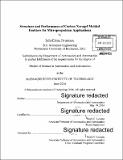| dc.contributor.advisor | Paulo C. Lozano. | en_US |
| dc.contributor.author | Jivanescu, Iulia Elena | en_US |
| dc.contributor.other | Massachusetts Institute of Technology. Department of Aeronautics and Astronautics. | en_US |
| dc.date.accessioned | 2016-12-05T19:55:06Z | |
| dc.date.available | 2016-12-05T19:55:06Z | |
| dc.date.copyright | 2016 | en_US |
| dc.date.issued | 2016 | en_US |
| dc.identifier.uri | http://hdl.handle.net/1721.1/105616 | |
| dc.description | Thesis: S.M., Massachusetts Institute of Technology, Department of Aeronautics and Astronautics, 2016. | en_US |
| dc.description | Cataloged from PDF version of thesis. | en_US |
| dc.description | Includes bibliographical references (pages 91-94). | en_US |
| dc.description.abstract | Ion electrospray propulsion relies on the transport of propellant to emission sites where ions and/or droplets are extracted to create thrust. The focus of this research is the creation of porous emitter substrates through which the liquid is passively transported. Previous substrates were created subtractively by selectively removing material to reveal emitter tips or arrays. The limitations of the previous substrates are pore size variability, non-uniform emitter tips, and difficulty in creating identical tips. This study investigates the use of carbon xerogels for electrospray applications due to their exceptional properties such as large surface to volume ratio, robustness and pore uniformity. The substrates are created through a synthesis route which is advantageous for reproducibility. Single carbon xerogel emitter tips and emitter arrays are molded on previously synthesized carbon xerogel substrates. Molding is an additive method which allows for parallel processing and batch manufacturing. Initially carbon xerogels substrates are synthesized. Then a carbon xerogel emitter tip is molded on top of a previously synthesized carbon substrate. Finally, an array of resorcinol formaldehyde emitters is molded on top of a carbon substrate. The carbon xerogel substrate with a molded tip is tested for Retarding Potential Analysis and Time of Flight Mass Spectrometry measurements in order to determine fragmentation fractions and beam composition. The results are consistent with the ionic liquid EMI-BF4 fragmentation fractions and pure ionic regime is achieved. The beam is nearly monoenergetic and fragmentation occurs mostly outside the acceleration region which does not affect thruster efficiency. | en_US |
| dc.description.statementofresponsibility | by Iulia Elena Jivanescu. | en_US |
| dc.format.extent | 94 pages | en_US |
| dc.language.iso | eng | en_US |
| dc.publisher | Massachusetts Institute of Technology | en_US |
| dc.rights | M.I.T. theses are protected by copyright. They may be viewed from this source for any purpose, but reproduction or distribution in any format is prohibited without written permission. See provided URL for inquiries about permission. | en_US |
| dc.rights.uri | http://dspace.mit.edu/handle/1721.1/7582 | en_US |
| dc.subject | Aeronautics and Astronautics. | en_US |
| dc.title | Structure and performance of carbon xerogel molded emitters for micropropulsion applications | en_US |
| dc.type | Thesis | en_US |
| dc.description.degree | S.M. | en_US |
| dc.contributor.department | Massachusetts Institute of Technology. Department of Aeronautics and Astronautics | |
| dc.identifier.oclc | 962733308 | en_US |
